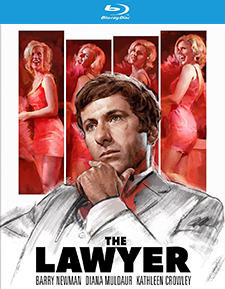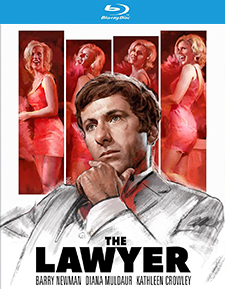Lawyer, The (Blu-ray Review)

Director
Sidney J. FurieRelease Date(s)
1970 (May 21, 2024)Studio(s)
Furie Productions/Paramount Pictures (Kino Lorber Studio Classics)- Film/Program Grade: B-
- Video Grade: A
- Audio Grade: A
- Extras Grade: A
Review
The Lawyer is loosely based on the case of Ohio doctor Sam Sheppard who was convicted of murdering his pregnant wife but won a new trial after the U.S. Supreme Court ruled that publicity and a “carnival atmosphere” had prejudiced the jury. F. Lee Bailey became well known nationally as Sheppard’s defense attorney.
Tony Petrocelli (Barry Newman, Bowfinger), an Italian-American, Harvard-educated attorney in the wealthy Southwestern cattle town of Baker, takes on the case of physician Jack Harrison (Robert Colbert, Scorpion), who stands accused of murdering his wife Wilma (Mary Wilcox, Love Me Deadly). The doctor claims he had been drinking while out with his wife and another couple, passed out on a downstairs couch, and woke up groggily to see an indistinct figure struggling with his wife. The evidence against him is shaky and Petrocelli is determined to prove him not guilty beyond a reasonable doubt. Defending him in court will require Petrocelli to go up against his mentor, prosecutor Eric P. Scott (Harold Gould, The Sting).
The Lawyer, a courtroom procedural featuring an aggressive young attorney, is slow getting started. It takes a while for the film to hammer home that Petrocelli drives a camper rather than a car, parks illegally and accumulates countless tickets, swigs root beer all day, is forever correcting how people pronounce his name, and is in love with his secretary. His swagger, quirks, and eager-beaver style are clearly designed to make the courtroom case more interesting, but the film takes far too long to get where it’s going and fails to hold the viewer when it should be building suspense about whether Dr. Harrison is guilty or innocent.
Director Sidney J. Furie shows us three versions of the murder in a Rashomon-like portrayal of the grisly killing from differing perspectives to keep us guessing. Harrison is an elusive character with an unusual alibi, so he might be guilty, but he staunchly denies killing his wife. Though this sounds like an interesting treatment of an intriguing premise, the film turns out to be nothing special. Even the fact it’s based on real events fails to add interest since the actual crime took place in 1954. The notoriety that the case excited 70 years ago hardly registers with modern viewers, and director Furie never causes us to feel the significance of the trial. Other films based on historical trials, such as Inherit the Wind, Erin Brockovich, Amistad, and Judgment at Nuremberg, are far more successful at riveting the viewer.
One of the problems is Newman as the lead. Because he doesn’t convey much of a personality, he fails to generate interest in his character or the story. Apart from a few quirks, we know little about the character, so he’s never more than a metaphor for justice, spouting platitudes about the law as he overconfidently takes on a tough case. Real star power in the lead role would have helped a lot. Newman’s screen presence makes Petrocelli oddly bland and gives the film a made-for-TV feel. In fact, Newman went on to star in Petrocelli, a TV series based on The Lawyer, which ran for two seasons on NBC in the mid-70s.
Character actor Harold Gould is very good as the prosecuting attorney. Chomping candy as he spouts legalese is a refreshing touch in a film that sorely needs some lighter moments. His character’s asides with Petrocelli display a friendly competitiveness. There are no shocking revelations, courtroom trickery, withheld information, or surprise witnesses. Things run pretty smoothly, but that often contributes to dull sequences. For a feature film, the lack of visual variety is surprising. Yes, most of the film consists of the trial and an appeal that needlessly drags it out, but there are untapped opportunities to open the film up more.
The Lawyer was shot by director of photography Ralph Woolsey on 35 mm film with spherical lenses and presented in the aspect ratio of 1.85:1. The Blu-ray is sourced from a Paramount Pictures 2021 HD master from a 4K scan of the 35 mm original camera negative. No visual imperfections are present, such as scratches, embedded dirt specks, or emulsion clouding. Contrast and clarity are excellent. Color palette looks especially good in the bold colors. The bright yellow of the opening credits, for example, really pops. The murder scene is intentionally blurred so that we can’t clearly see the killer. Tasteful nudity is part of these key scenes. The few outdoor scenes must have been shot on overcast days, since there’s little or no bright sunshine, which may be appropriate for the film’s serious subject matter.
The soundtrack is English 2.0 DTS-HD Master Audio. Optional English SDH subtitles are available. Dialogue is clear and distinct, which is important when the lion’s share of the film is devoted to the courtroom drama. In the outdoor scenes, ambient traffic noise is well balanced with dialogue. Malcolm Dodds’ score is lively, with a bouncy beat.
Bonus materials on the Region A Blu-ray release from Kino Lorber Studio Classics include the following:
- Audio Commentary by Daniel Kremer and Paul Lynch
- Newman’s Law: Interview with Barry Newman (21:35)
- Lawyers’ Wives and Lost Loves: Interview with Actress Diana Muldaur (10:57)
- Teaser Trailer (:41)
- The Seduction of Joe Tynan Trailer (2:11)
- Puzzle of a Downfall Child Trailer (1:51)
- Hardcore Trailer (1:22)
- The Ipcress File Trailer (3:07)
- The Appaloosa Trailer (2:44)
Audio Commentary – Film historian/filmmaker Daniel Kremer and film director Paul Lynch collaborate on this informative commentary about The Lawyer. Director Sidney J. Furie was brought up in Canada and wasn’t good at self-promoting. “You have to be a huckster to get into the business.” A lot of luck was involved in Furie’s career. Having worked with stars, he had become jaded and preferred working with good actors that didn’t come with big egos. Produced by Brad Dexter, The Lawyer is driven by energy. Dexter had appeared as an actor in B films since the 1940s. The Lawyer was originally going to be produced by Bob Evans and it was announced that F. Lee Bailey, the defense attorney in the case the film is based on, would star. The original Sheppard case inspired the film The Fugitive. In the look of the film, Furie was trying to be somewhat experimental. Furie isn’t a fan of “hot lighting,” overly bright lighting. He prefers shadows and atmospheric lighting. More intense illumination gives film a flat look. Furie is impatient with directors of photography who take a long time to light. An inventive cameraman works with the director to realize his vision. The photography isn’t showy, but occasionally a shot will feature an interesting angle. The viewer is so absorbed that he isn’t aware of what the camera is doing. Many takes are long because the drama is compelling. Soon after The Lawyer was made, producers demanded stars in films for box office assurance. No longer would a non-star be chosen as the lead in a major motion picture.
Newman’s Law: Interview with Star Barry Newman – Newman tells how he learned about The Lawyer. He met Sidney J. Furie, they spoke for a long time about many topics, Furie set up a camera and started ad-libbing with Newman. Furie told Newman he was looking for a star to be the lead in The Lawyer, but if he couldn’t find one, Newman had the job. In the meantime, Newman worked with Ali McGraw who was preparing for a role in Goodbye, Columbus. Newman discusses the Sheppard case that forms the basis of The Lawyer. He met F. Lee Bailey at Harvard. Director Furie gave Newman a lot of freedom in shaping his role, making him comfortable and building his confidence. There were no tense moments on the set. “It was an easy shoot.” Furie and producer Brad Dexter showed Newman the Hollywood scene. Exteriors were filmed in Colorado Springs. Paramount never got behind the film with promotion. When Furie was at one point attached to The Godfather project, he gave Newman the book and asked him which part he’d want to play. When an offer came to star in a TV series spinoff called Petrocelli, Newman turned it down because the original script wasn’t true to the character he had created in The Lawyer. When the writers made the script truer to the film, Newman agreed to star. The series ran for two seasons, won an Emmy for the show and a Golden Globe for Newman.
Lawyers’ Wives and Lost Loves: Interview with Actress Diana Muldaur – Two interviews are contained. The first is a telephone interview from 2013, the second is an on-camera interview filmed on the set of Furie’s Finding Hannah. In the phone interview, Muldaur reminisces about her role in The Lawyer, Furie’s directing style, and his ability to find “business” for her in her scenes. As we hear Muldaur’s voice, clips from her scenes in The Lawyer are shown. She sums up her experience by saying “Everything was copacetic.” In the Finding Hannah interview, she talks about Furie’s lifelong obsession with the Holocaust and reuniting with Barry Newman, her co-star in The Lawyer 50 years earlier. She speaks highly of Barry Newman as both actor and human being. Muldaur got a call from Furie after decades. She says it was a joy to work in Finding Hannah. Clips from Finding Hannah are shown. Muldaur discusses the differences between working in independent films and studio pictures.
The Lawyer has a few surprises in this courtroom drama but never achieves anything more than a journeyman effort. When the film seems about to come to a close, it continues adding to the story with new developments. For those who enjoy courtroom drama, the film will likely deliver, but it lacks sparkle in terms of direction, Newman’s performance, and lugubrious script.
- Dennis Seuling

